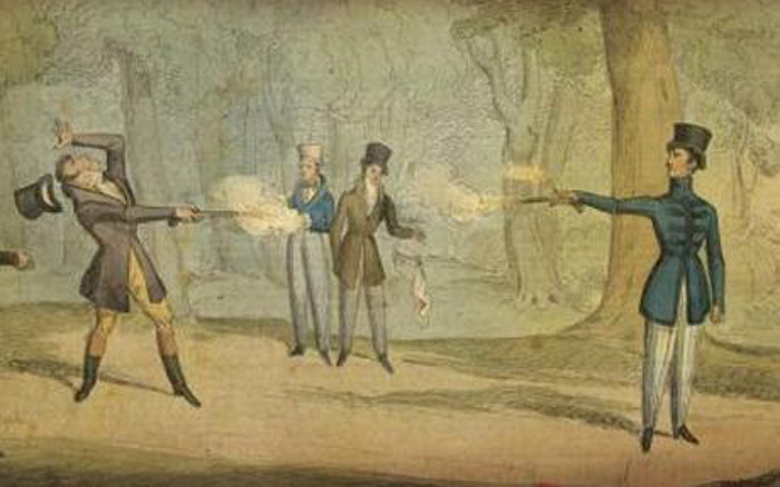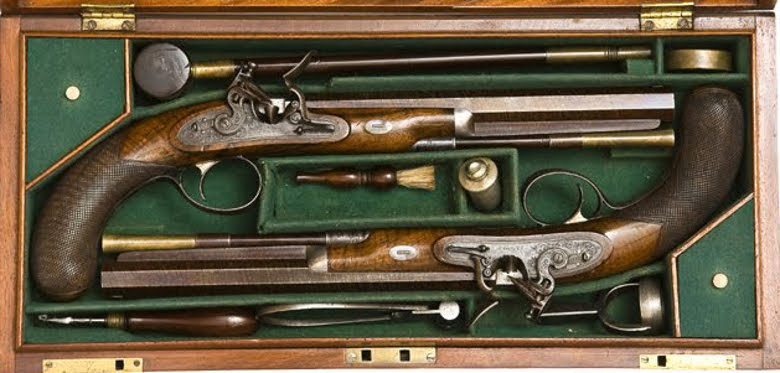We hope you enjoy the articles and short stories presented here, and will join Kate in her adventures for many years to come.
Upon request, you will receive an inscribed copy of Kate Tattersall Adventures in China with every donation of $10 or more plus shipping. Please use the Contact Page to provide your shipping address and we will reply with your total.
By the 1840s pistols were the weapon of choice for duels in Britain. Learning to properly defend oneself with a sabre took far more practise and skill. It also required physical conditioning, as strength, stamina, and agility, improved one’s swordplay. To take up a pistol, aim straight and pull a trigger, could be reasonably accomplished by anyone. There was an attitude flouted about that swords were for frivolous matters, when “first blood” was adequate to decide a quarrel, and a true gentleman would only engage in a duel when it was worth his life; therefore pistols at close range, a bullet burying itself anywhere in a body generally proving instantly fatal, or from infection. It was probably also a convenient excuse not to stay in shape and spend hours training with a sword master.

These gentlemen appear to be firing from about six paces at the drop of a handkerchief.
While duelling with sabres seemed to be simple (opponents facing each other on a piece of secluded turf) there were countless variations to pistol duels which would be worked out by the seconds; standing and firing at the drop of a handkerchief, striding towards each other and firing at will, marching to a beat away from each other then turning and firing, &c. Ultimately, it came down to the combatants shooting upon one another at close range, usually once. If neither man was hit and the challenger felt honour had been served the duel would be declared over. If the offended party was not satisfied, a pistol duel could continue until one man was hit, but the seconds and witnesses would often try to prevent further combat. To have more than three exchanges of fire was frowned upon as ungentlemanly and farcical, an embarrassment for both parties. The smooth bore flintlock pistols commonly used up until the 1860s were notoriously inaccurate and prone to misfiring. If duelling had gone on with the rifled barrels which were developed throughout the 19th century fatality rates would have been extremely high, but I suppose gentlemen would have continued to use the old weapons.

A brace of duelling pistols, manufactured by James Purdey & Sons, London.
Typically, it was the Irish, a people with such a deep love of single combat (whether it be with fists, bricks, sticks, sabres, or pistols), who made the most comprehensive duelling document, known as the Code Duello, written in 1777. These rules were created to make pistol duelling more civilized, but it made some notes about swordplay as well, and how varying degrees of insults should be handled. Every gentleman was expected to carry the code in the case with his brace of duelling pistols.
Code Duello, The Twenty-six Commandments
I. The first offence requires the first apology, though the retort may have been more offensive than the insult. Example: A tells B he is impertinent, &c. B retorts that he lies; yet A must make the first apology, because he gave the first offence, and (after one fire) B may explain away the retort by subsequent apology.
II. But if the parties would rather fight on, then, after two shots each (but in no case before), B may explain first and A apologise afterwards. N.B. The above rules apply to all cases of offences in retort not of a stronger class than the example.
III. If a doubt exists who gave the first offence, the decision rests with the seconds. If they will not decide or cannot agree, the matter must proceed to two shots, or to a hit if the challenger requires it.
IV. When the lie direct is the first offence, the aggressor must either beg pardon in express terms, exchange two shots previous to apology, or three shots followed by explanation, or fire on till a severe hit be received by one party or the other.
V. As a blow is strictly prohibited under any circumstances among gentlemen, no verbal apology can be received for such an insult. The alternatives, therefore, are: The offender handing a cane to the injured party to be used on his back, at the same time begging pardon, firing until one or both are disabled; or exchanging three shots and then begging pardon without the proffer of the cane. N.B. If swords are used, the parties engage until one is well blooded, disabled, or disarmed, or until, after receiving a wound and blood being drawn, the aggressor begs pardon.
VI If A gives B the lie and B retorts by a blow (being the two greatest offences), no reconciliation can take place till after two discharges each or a severe hit, after which B may beg A’s pardon for the blow, and then A may explain simply for the lie, because a blow is never allowable, and the offence of the lie, therefore, merges in it. (See preceding rule.) N.B. Challenges for undivulged causes may be conciliated on the ground after one shot. An explanation or the slightest hit should be sufficient in such cases, because no personal offence transpired.
VII. But no apology can be received in any case after the parties have actually taken their ground without exchange of shots.
VIII. In the above case no challenger is obliged to divulge his cause of challenge (if private) unless required by the challenged so to do before their meeting.
IX. All imputations of cheating at play, races, &c, to be considered equivalent to a blow, but may be reconciled after one shot, on admitting their falsehood and begging pardon publicly.
X. Any insult to a lady under a gentleman’s care or protection to be considered as by one degree a greater offence than if given to the gentleman personally, and to be regarded accordingly.
XI. Offences originating or accruing from the support of ladies’ reputations to be considered as less unjustifiable than any others of the same class, and as admitting of slighter apologies by the aggressor. This is to be determined by the circumstances of the case, but always favourably to the lady.
XII. No dumb firing or firing in the air is admissible in any case. The challenger ought not to have challenged without receiving offence, and the challenged ought, if he gave offence, to have made an apology before he came on the ground; therefore children’s play must be dishonourable on one side or the other, and is accordingly prohibited.
XIII. Seconds to be of equal rank in society with the principals they attend, inasmuch as a second may either choose or chance to become a principal and equality is indispensable.
XIV. Challenges are never to be delivered at night, unless the party to be challenged intends leaving the place of offence before morning; for it is desirable to avoid all hotheaded proceedings.
XV. The challenged has the right to choose his own weapons unless the challenger gives his honour he is no swordsman, after which, however, he cannot decline any second species of weapon proposed by the challenged.
XVI. The challenged chooses his ground, the challenger chooses his distance, the seconds fix the time and terms of firing.
XVII. The seconds load in presence of each other, unless they give their mutual honours that they have charged smooth and single, which shall be held sufficient.
XVIII. Firing may be regulated, first, by signal; secondly by word of command; or, thirdly at pleasure, as may be agreeable to the parties. In the latter case, the parties may fire at their reasonable leisure, but second presents and rests are strictly prohibited.
XIX. In all cases a misfire is equivalent to a shot, and a snap or a non-cock is to be considered a misfire.
XX. Seconds are bound to attempt a reconciliation before the meeting takes place or after sufficient firing or hits as specified.
XXI. Any wound sufficient to agitate the nerves and necessarily make the hand shake must end the business for that day.
XXII. If the cause of meeting be of such a nature that no apology or explanation can or will be received, the challenged takes his ground and calls on the challenger to proceed as he chooses. In such cases firing at pleasure is the usual practise, but may be varied by agreement.
XXIII. In slight cases the second hands his principal but one pistol, but in gross cases two, holding another case ready charged in reserve.
XXIV. When the seconds disagree and resolve to exchange shots themselves, it must be at the same time and at right angles with their principals. If with swords, side by side, with five paces interval.
XXV. No party can be allowed to bend his knee or cover his side with his left hand, but may present at any level from the hip to the eye.
XXVI. None can either advance or retreat if the ground is measured. If no ground be measured, either party may advance at his pleasure, even to the touch of muzzles, but neither can advance on his adversary after the fire, unless the adversary steps forward on him. N.B. The seconds on both sides stand responsible for this last rule being strictly observed, bad cases having occurred from neglecting it. N.B. All matters and doubts not herein mentioned will be explained and cleared up by application to the Committee, who meet alternately at Clonmel and Galway at the quarter sessions for that purpose.
Crow Ryan, President. James Keogh. Amby Bodkin, Secretaries. Clonmel Summer Assizes, 1777.

I can`t imagine standing there and shooting at each other. The duel in Onegin had me squirming. Interesting posts!
I wonder how many people actually followed all the rules of the code.
Yes! I saw Onegin too. I wonder if they duelled out on the dock for legal reasons? Russia probably had different laws.
Nice content.
In Russian literature, they always talk about dueling *across* a handkerchief. I cannot figure out what that means because they never explain it. What is this “across”? Is it the same as “at the drop of” as you mention above?
@ Dave, yes, the handkerchief would fall to the ground and the duellists would then shoot across it. In those circumstances they were waiting for the handkerchief to reach the ground before firing. A ‘duel across a handkerchief’ was also a way to refer to a battle in a tight area. Lastly, it was known for combatants to hold a handkerchief between them and go at each other with daggers, swords, or pistols.
@Daphne A lot of people ignored rules, like intentionally missing, and some duels used weapons like pool balls, rifles, and hot air balloons, so the Code could only apply so far. Others like Andrew Jackson ignored the rule that misfires count as a shot, and having to announce one was hit to end the duel, instead firing and killing his opponent and suffered a loss of reputation.
Thanks on your marvellous posting! I enjoyed reading it, you’re a great author.
Very interesting reading. I am a reenactor of the American Fur trade 1780-1840 and both build and shoot blackpowder pistols and rifles. I have built both percussion and flintlock cased dueling pistols. I have heard of the British Royal Dueling society that still practise dueling with raincoats and face shields using wax projectiles for safety and would like to start a dueling club in America, but don’t think I could get a permit to do so. I am of British heritage and love reading about British history both fiction and non fiction. Thank you for your stories! My ancestors came to America in 1734 from Binbrook England.
Thanks for the great guide.